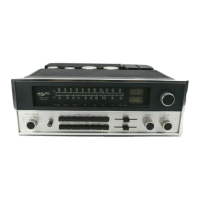continues as usual. When the switch is in the OUT
position normal program from the source is heard.
HOW TO COPY TAPE
1. Put the tape to be copied on the recorder con-
nected to TAPE 1 input.
2. Turn the input selector to TAPE 1.
3. The signal available at the TAPE OUTPUT
jacks is the playback of TAPE 1.
4. Record on the recorder connected to TAPE
2. The recording can be monitored by pressing
in the TAPE 2 pushbutton. Instantaneous
comparison of the recorded program with the
original can be heard.
LISTENING TO AM
Turn the INPUT SELECTOR to AM.
Rotate the tuning knob of the station of your
choice.
Adjust the volume to a comfortable level.
LISTENING TO FM or FM STEREO
Turn the INPUT SELECTOR to FM.
Push the STEREO MODE selector pushbutton in.
Rotate the tuning knob to the station of your
choice.
Adjust the volume to a comfortable level.
The MAC 1900 uses a Mclntosh developed auto-
matic mono-stereo switching circuit. The switching
is electronic without switching clicks or transients.
The circuit switches smoothly and silently when
the 19,000 Hz multiplex pilot signal is present. When
the FM MPX indicator is lit, the station is broadcast-
ing a 19,000 Hz pilot carrier. This signal causes the
automatic circuit to switch the MAC 1900 to stereo. If
a station is not broadcasting a 19,000 Hz pilot signal
for stereo, the FM MPX indicator will remain off and
the tuner will automatically switch to mono.
The muting circuit suppresses all noise between
stations. It suppresses all weaker stations not strong
enough to override the background noise. The muting
threshold setting determines the strength of the sig-
nal which can be heard with muting in operation. The
muting threshold is carefully adjusted to optimum at
the factory.
While tuning you may notice that the tuning in-
dicator will show a station yet no program is heard
from the speakers. The muting circuit in the tuner has
rejected the station because there is objectionable
noise with the weak signal from the station. Push the
MUTING pushbutton to the OUT position and the sta-
tion will be heard. Most programs that can be tuned
in this manner are of poor quality due to interfering
noise.
Performance Limits
PREAMPLIFIER AND POWER AMPLIFIER SECTION
POWER OUTPUT: 55 RMS watts continuous per
channel into 4 or 8 ohms both channels operating
20 Hz to 20,000 Hz.
30 RMS watts continuous per channel into 16
ohms both channels operating 20 Hz to 20,000 Hz.
HARMONIC DISTORTION: Does not exceed 0.20%
at rated power output from 20 Hz to 20,000 Hz with
both channels operating. Typical performance is less
than 0.1% at rated power. Distortion decreases as
output power is reduced.
INTERMODULATION DISTORTION: Does not exceed
0.20% if instantaneous peak power output is twice
rated power or less per channel with both channels
operating for any combination of frequencies 20 Hz
to 20,000 Hz.
DAMPING FACTOR: 50 across 8 ohm load
FREQUENCY RESPONSE: ±0.5 dB 20 Hz through
20,000 Hz
INPUT SENSITIVITY AND IMPEDANCE:
Power Amplifier: 2.5 volts, 100k ohms
Phono 1 and Phono 2: 2.0 mV, 47k ohms
Tape 1 and Tape 2: 250 mV, 250k ohms
TOTAL NOISE:
Power Amplifier: 95 dB below rated output
Tape Input: 90 dB below rated output
Phono Input: 76 dB below 10 mV input
TAPE OUTPUT:
Tuner: 1.0 volt
Tape: 250 mV with rated input from low level in-
puts
Phono: 1.2 volts with 10 mV input at 1,000 Hz
Preamp Output: 2.5 volts with rated input
BASS CONTROLS: ±16 dB at 20 Hz
TREBLE CONTROLS: ±16 dB at 20,000 Hz
L. F. FILTER: Active filter, 12 dB per octave roll off
below 50 Hz, down 18 dB at 20 Hz
H. F. FILTER: Active filter, 12 dB per octave roll off
above 7,000 Hz, down 18dB at 20,000 Hz
AM TUNER SECTION
SENSITIVITY: 75 µV IHF (external ant.)
SIGNAL TO NOISE RATIO: 45 dB minimum IHF; 55
dB at 100% modulation
12

